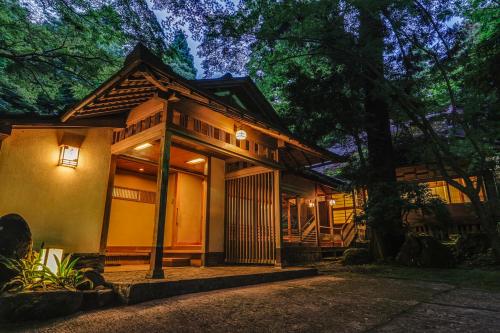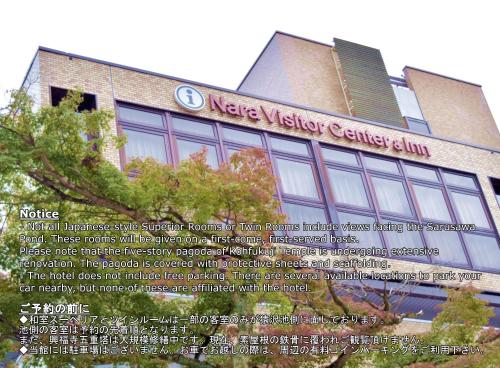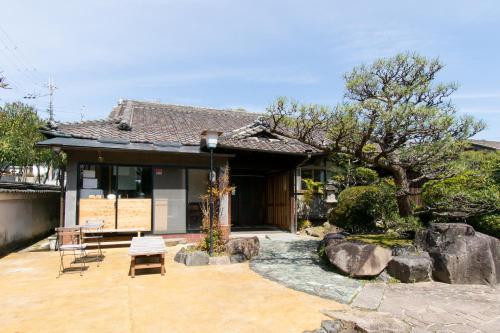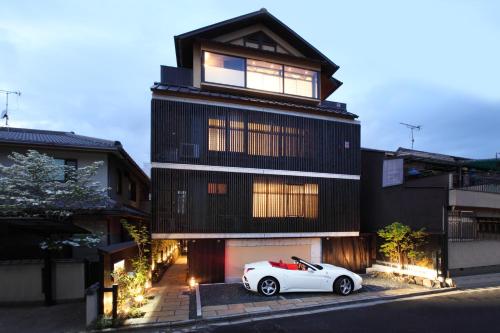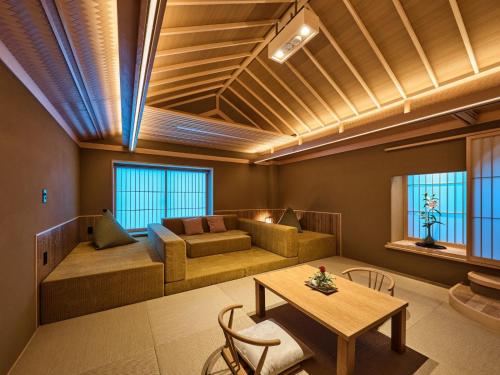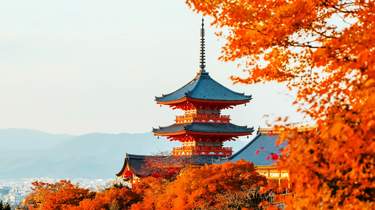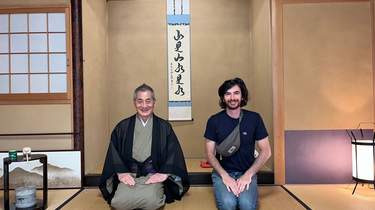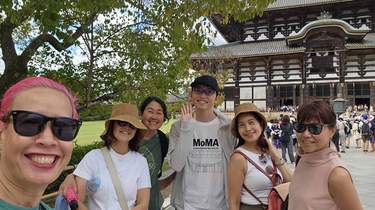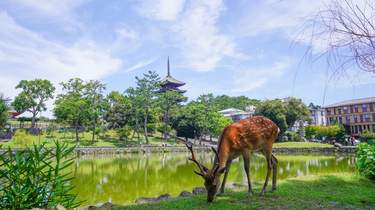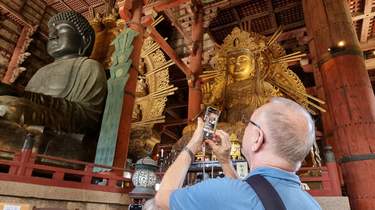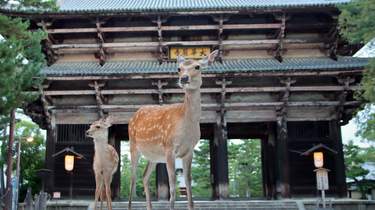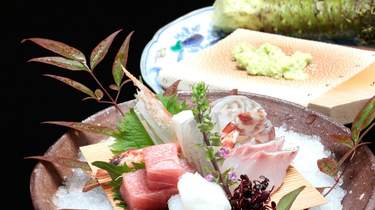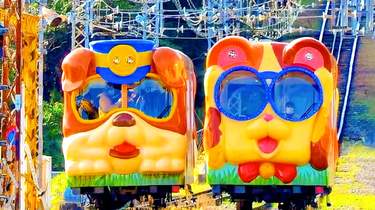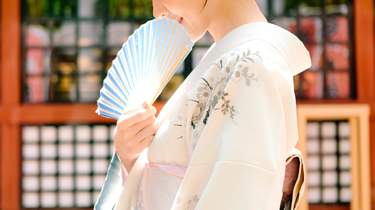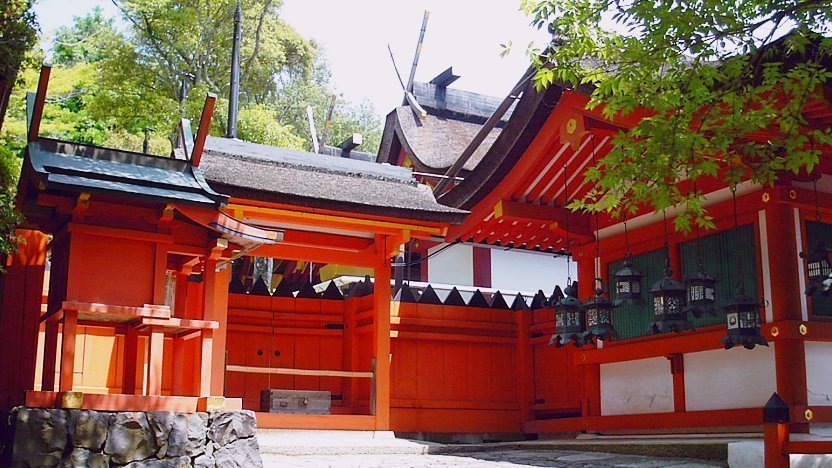
Kasuga Taisha (Åtō·æÕÄą) is Nara's most celebrated shrine. It was established at the same time as the capital and is dedicated to the deity responsible for the protection of the city. Kasuga Taisha was also the tutelary shrine of the Fujiwara, Japan's most powerful family clan during most of the Nara and Heian Periods. Like the Ise Shrines, Kasuga Taisha had been periodically rebuilt every 20 years for many centuries. In the case of Kasuga Taisha, however, the custom was discontinued at the end of the Edo Period.
Beyond the shrine's offering hall, which can be visited free of charge, there is a paid inner area which provides a closer view of the shrine's inner buildings. Furthest in is the main sanctuary, containing multiple shrine buildings that display the distinctive Kasuga style of shrine architecture, characterized by a sloping roof extending over the front of the building.
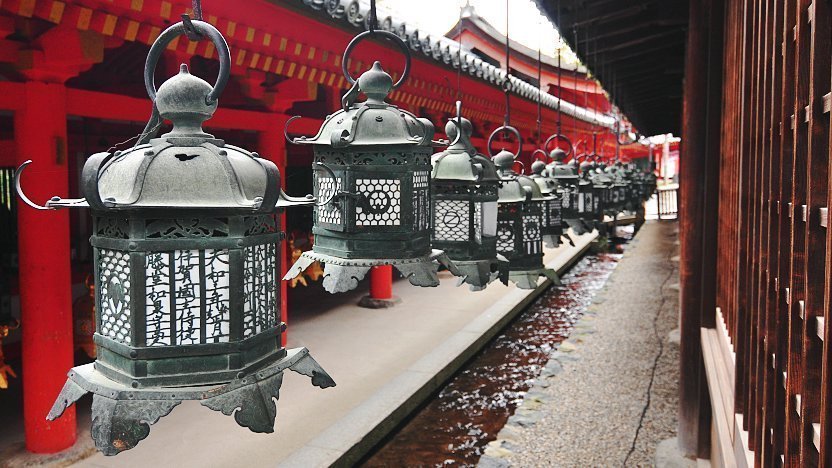
Kasuga Taisha is famous for its lanterns, which have been donated by worshippers. Hundreds of bronze lanterns can be found hanging from the buildings, while as many stone lanterns line its approaches. The lanterns are only lit twice a year during two Lantern Festivals, one in early February and one in mid August.
There are many smaller auxiliary shrines in the woods around Kasuga Taisha, twelve of which are located along a path past the main shrine complex and are dedicated to the twelve lucky gods. Among them are Wakamiya Shrine, an important cultural property known for its dance festival, and Meoto Daikokusha, which enshrines married deities and is said to be fortuitous to matchmaking and marriage.
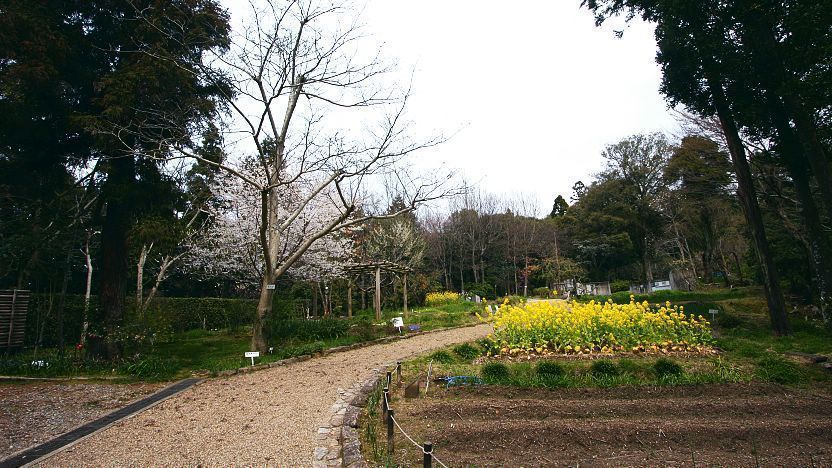
Located a short walk from the Kasuga Shrine main complex is the Kasuga Taisha Shinen Manyo Botanical Garden. This garden displays about 250 kinds of plants described in the Manyoshu, Japan's oldest collection of poems which dates to the Nara Period. A large part of the garden is dedicated to wisteria flowers which usually bloom from late April to early May.
The shrine grounds also contain the Kasuga Taisha Museum, a treasure hall near the main complex which displays some of the shrine's relics. These include two sets of large ornate drums. Additionally, the Kasuga Primeval Forest, a sacred old-growth forest belonging to the shrine, covers the mountain behind Kasuga Taisha, however, it is closed to the public.
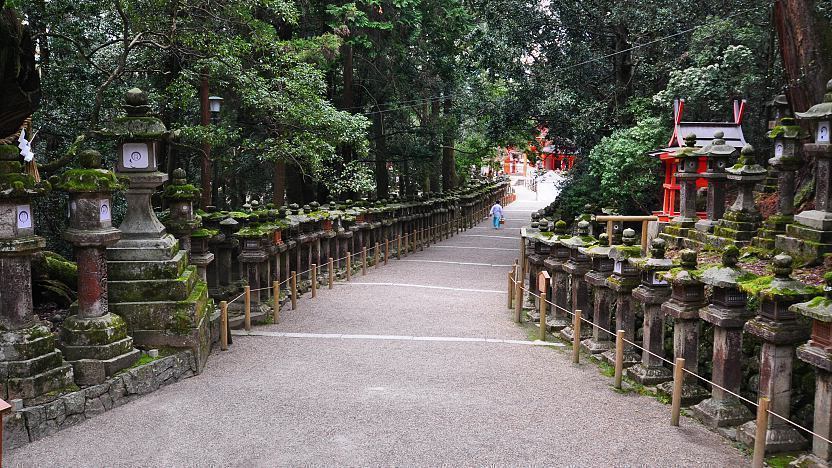
Getting there and around
Hours and Fees
Kasuga Taisha
Hours
7:00 to 17:00 (November to February)
Inner area: 9:00 to 16:00
Closed
Admission
Kasuga Taisha Museum
Hours
Closed
Admission
Botanical Garden
Hours
Closed
Admission
Questions? Ask in our forum.
Links and Resources
English
Japanese
Hotels around Nara
-
-
![]() Guest House OkuLocated 1.8 km from Nara Station, 18 km from Iwafune Shrine and 22 km from Higashiosaka Hanazono Rugby Stadium, Guest House Oku provides accommodation situated in Nara. This 2-star guest house offers luggage storage space and bicycle parking. The guest house features family rooms. With a shared bathroom, units at the guest house also offer free WiFi. Nippon Christ Kyodan Shijonawate Church is 23 km from the guest house, while Shijonawate City Museum of History and Folklore is 23 km away. Itami Airport is 53 km from the property.View on Booking.com
Guest House OkuLocated 1.8 km from Nara Station, 18 km from Iwafune Shrine and 22 km from Higashiosaka Hanazono Rugby Stadium, Guest House Oku provides accommodation situated in Nara. This 2-star guest house offers luggage storage space and bicycle parking. The guest house features family rooms. With a shared bathroom, units at the guest house also offer free WiFi. Nippon Christ Kyodan Shijonawate Church is 23 km from the guest house, while Shijonawate City Museum of History and Folklore is 23 km away. Itami Airport is 53 km from the property.View on Booking.com -
![]() TsukihiteiTsukihitei is located in the Kasugayama Primeval Forest, a UNESCO World Heritage site. Each guest room has a Japanese-style decor and offer panoramic forest views, traditional tatami (woven-straw) floors, and shoji paper screens. All guest rooms are equipped with Japanese-style futon beds. The rooms have an en suite bathroom. Kasuga Taisha Shrine is 400 metres away from the property. Todaiji Temple is about a 10-minute walk away. Kintetsu Nara Train Station and JR Nara Train Station are both less than a 10-minute drive away. Japanese-style breakfast and a set meal course dinners are prepared by the Japanese chef using seasonal specialities.View on Booking.com
TsukihiteiTsukihitei is located in the Kasugayama Primeval Forest, a UNESCO World Heritage site. Each guest room has a Japanese-style decor and offer panoramic forest views, traditional tatami (woven-straw) floors, and shoji paper screens. All guest rooms are equipped with Japanese-style futon beds. The rooms have an en suite bathroom. Kasuga Taisha Shrine is 400 metres away from the property. Todaiji Temple is about a 10-minute walk away. Kintetsu Nara Train Station and JR Nara Train Station are both less than a 10-minute drive away. Japanese-style breakfast and a set meal course dinners are prepared by the Japanese chef using seasonal specialities.View on Booking.com -
![]() NARA Visitor Center and InnThe Nara Visitor Center and Inn is situated in the heart of Nara, just a 3-minute walk from Kofuku-ji Temple and Naramachi. The Todai-ji Temple and Deer Park are a 10-minute stroll away, while Nara Station on the Kintetsu Line is a 7-minute walk. JR Nara Station is 14-minutes away on foot. All guest rooms feature air conditioning and heating, and are equipped with a fridge and flat-screen TV. Japanese samue nightwear are available to all staying guests. Some units come equipped with an en suite bathroom with a shower, while some Japanese-style rooms come with an en suite shower. Japanese-style rooms feature tatami (woven-straw) floors and Japanese futon bedding. The property offers free WiFi access and a 24-hour front desk. Luggage storage is available. There is a public bath on site, where guests will find free toiletries and hairdryers. A coin launderette, a shared kitchen and free-use internet PCs are offered on site. The on-site tourist information desk offers information in English, Chinese and Korean. Services offered at the desk include transport and meal tickets at a discount, currency exchange, bike hire at a charge, cultural activities at an additional charge, such as Japanese calligraphy lessons, and tour arrangements. Some cultural activities such as origami folding are offered free of charge.View on Booking.com
NARA Visitor Center and InnThe Nara Visitor Center and Inn is situated in the heart of Nara, just a 3-minute walk from Kofuku-ji Temple and Naramachi. The Todai-ji Temple and Deer Park are a 10-minute stroll away, while Nara Station on the Kintetsu Line is a 7-minute walk. JR Nara Station is 14-minutes away on foot. All guest rooms feature air conditioning and heating, and are equipped with a fridge and flat-screen TV. Japanese samue nightwear are available to all staying guests. Some units come equipped with an en suite bathroom with a shower, while some Japanese-style rooms come with an en suite shower. Japanese-style rooms feature tatami (woven-straw) floors and Japanese futon bedding. The property offers free WiFi access and a 24-hour front desk. Luggage storage is available. There is a public bath on site, where guests will find free toiletries and hairdryers. A coin launderette, a shared kitchen and free-use internet PCs are offered on site. The on-site tourist information desk offers information in English, Chinese and Korean. Services offered at the desk include transport and meal tickets at a discount, currency exchange, bike hire at a charge, cultural activities at an additional charge, such as Japanese calligraphy lessons, and tour arrangements. Some cultural activities such as origami folding are offered free of charge.View on Booking.com -
![]() NIPPONIA HOTEL NARA NARAMACHILocated in Nara, 1.1 km from Nara Station, NIPPONIA HOTEL NARA NARAMACHI provides accommodation with a garden, free private parking and a restaurant. Located around 22 km from Higashiosaka Hanazono Rugby Stadium, the hotel with free WiFi is also 23 km away from Nippon Christ Kyodan Shijonawate Church. The property is allergy-free and is set 19 km from Iwafune Shrine. All units at the hotel are equipped with a seating area. The private bathroom is equipped with a bidet, free toiletries and a hairdryer. At NIPPONIA HOTEL NARA NARAMACHI, every room is equipped with air conditioning and a safety deposit box. Guests at the accommodation can enjoy an Asian breakfast. Shijonawate City Museum of History and Folklore is 23 km from NIPPONIA HOTEL NARA NARAMACHI, while Aeon Mall Shijonawate is 25 km away. Itami Airport is 53 km from the property.View on Booking.com
NIPPONIA HOTEL NARA NARAMACHILocated in Nara, 1.1 km from Nara Station, NIPPONIA HOTEL NARA NARAMACHI provides accommodation with a garden, free private parking and a restaurant. Located around 22 km from Higashiosaka Hanazono Rugby Stadium, the hotel with free WiFi is also 23 km away from Nippon Christ Kyodan Shijonawate Church. The property is allergy-free and is set 19 km from Iwafune Shrine. All units at the hotel are equipped with a seating area. The private bathroom is equipped with a bidet, free toiletries and a hairdryer. At NIPPONIA HOTEL NARA NARAMACHI, every room is equipped with air conditioning and a safety deposit box. Guests at the accommodation can enjoy an Asian breakfast. Shijonawate City Museum of History and Folklore is 23 km from NIPPONIA HOTEL NARA NARAMACHI, while Aeon Mall Shijonawate is 25 km away. Itami Airport is 53 km from the property.View on Booking.com -
![]() Yuzan GuesthouseLocated in Nara and with Nara Station reachable within 1.3 km, Yuzan Guesthouse provides a garden, non-smoking rooms, free WiFi throughout the property and a terrace. This 1-star hostel offers a shared kitchen and luggage storage space. Nippon Christ Kyodan Shijonawate Church is 22 km from the hostel and Shijonawate City Museum of History and Folklore is 22 km away. The hostel offers certain rooms that include a safety deposit box, and each room has a shared bathroom with a shower and a hairdryer. Iwafune Shrine is 18 km from Yuzan Guesthouse, while Higashiosaka Hanazono Rugby Stadium is 21 km away. Itami Airport is 53 km from the property.View on Booking.com
Yuzan GuesthouseLocated in Nara and with Nara Station reachable within 1.3 km, Yuzan Guesthouse provides a garden, non-smoking rooms, free WiFi throughout the property and a terrace. This 1-star hostel offers a shared kitchen and luggage storage space. Nippon Christ Kyodan Shijonawate Church is 22 km from the hostel and Shijonawate City Museum of History and Folklore is 22 km away. The hostel offers certain rooms that include a safety deposit box, and each room has a shared bathroom with a shower and a hairdryer. Iwafune Shrine is 18 km from Yuzan Guesthouse, while Higashiosaka Hanazono Rugby Stadium is 21 km away. Itami Airport is 53 km from the property.View on Booking.com -
![]() Hotel RokuneSet in Nara, within 18 km of Iwafune Shrine and 21 km of Higashiosaka Hanazono Rugby Stadium, Hotel Rokune provides accommodation with free WiFi. Featuring a terrace, the 3-star hotel has air-conditioned rooms with a private bathroom. The property is non-smoking and is located 700 metres from Nara Station. All units are equipped with a fridge, microwave, a kettle, a bidet, free toiletries and a desk. The units in the hotel are equipped with a flat-screen TV and a hairdryer. Nippon Christ Kyodan Shijonawate Church is 22 km from Hotel Rokune, while Shijonawate City Museum of History and Folklore is 22 km away. Itami Airport is 52 km from the property.View on Booking.com
Hotel RokuneSet in Nara, within 18 km of Iwafune Shrine and 21 km of Higashiosaka Hanazono Rugby Stadium, Hotel Rokune provides accommodation with free WiFi. Featuring a terrace, the 3-star hotel has air-conditioned rooms with a private bathroom. The property is non-smoking and is located 700 metres from Nara Station. All units are equipped with a fridge, microwave, a kettle, a bidet, free toiletries and a desk. The units in the hotel are equipped with a flat-screen TV and a hairdryer. Nippon Christ Kyodan Shijonawate Church is 22 km from Hotel Rokune, while Shijonawate City Museum of History and Folklore is 22 km away. Itami Airport is 52 km from the property.View on Booking.com -
![]() Wakasa AnnexWakasa Annex features an outdoor hot public bath and free WiFi. Other facilities include a 24-hour reception, drinks vending machines and free parking. Todai-ji Temple is only an 8-minute walk. Soundproof rooms feature a serene interior with a tatami (woven-straw) floor, low furniture and shoji paper screens. Amenities include a flat-screen TV with satellite channels, a fridge and toiletries. Guests sleep in Japanese futon bedding, and the rooms come with an all-wooden bathroom. Luggage storage is offered before and after check-in/check-out. English maps for exploring the area are available, and the property staff organises free tours guided in English for staying guests. Annex Wakasa serves Japanese cuisine for breakfast and dinner at the dining area. Dinner is a traditional kaiseki multi-course meal featuring seasonal dishes. The hotel is an 8-minute walk from Japanese garden Isui-en, and a 15-minute walk from Nara Park. Nara Train Station is a 12-minute walk, while Kansai Airport is 80 minutes by bus.View on Booking.com
Wakasa AnnexWakasa Annex features an outdoor hot public bath and free WiFi. Other facilities include a 24-hour reception, drinks vending machines and free parking. Todai-ji Temple is only an 8-minute walk. Soundproof rooms feature a serene interior with a tatami (woven-straw) floor, low furniture and shoji paper screens. Amenities include a flat-screen TV with satellite channels, a fridge and toiletries. Guests sleep in Japanese futon bedding, and the rooms come with an all-wooden bathroom. Luggage storage is offered before and after check-in/check-out. English maps for exploring the area are available, and the property staff organises free tours guided in English for staying guests. Annex Wakasa serves Japanese cuisine for breakfast and dinner at the dining area. Dinner is a traditional kaiseki multi-course meal featuring seasonal dishes. The hotel is an 8-minute walk from Japanese garden Isui-en, and a 15-minute walk from Nara Park. Nara Train Station is a 12-minute walk, while Kansai Airport is 80 minutes by bus.View on Booking.com -
![]() Kotonoyado MusashinoKotono yado Musashino offers accommodation in Nara, and is located a 11-minute drive from Nara Station on the Kintetsu Nara Line. Free WiFi is provided throughout the property and free private parking is available on site. Every room includes a flat-screen TV. You will find a kettle in the room. Rooms include a shared bathroom. For your comfort, you will find slippers and a hair dryer. There is luggage storage space at the property. The ryokan also offers free use of bicycles. Kofuku-ji is 1.1 km from Musashino, while Kasuga Taisha is 300 metres from the property. The nearest airport is Osaka Itami Airport, 39 km from the property.View on Booking.com
Kotonoyado MusashinoKotono yado Musashino offers accommodation in Nara, and is located a 11-minute drive from Nara Station on the Kintetsu Nara Line. Free WiFi is provided throughout the property and free private parking is available on site. Every room includes a flat-screen TV. You will find a kettle in the room. Rooms include a shared bathroom. For your comfort, you will find slippers and a hair dryer. There is luggage storage space at the property. The ryokan also offers free use of bicycles. Kofuku-ji is 1.1 km from Musashino, while Kasuga Taisha is 300 metres from the property. The nearest airport is Osaka Itami Airport, 39 km from the property.View on Booking.com -
![]() Hilo HostelHilo Hostel is located in Nara, within less than 1 km of Nara Station and 18 km of Iwafune Shrine. Featuring a shared lounge, this 3-star hostel has air-conditioned rooms with a shared bathroom. The accommodation provides a shared kitchen and free WiFi. Higashiosaka Hanazono Rugby Stadium is 21 km from the hostel, while Nippon Christ Kyodan Shijonawate Church is 22 km away. Itami Airport is 53 km from the property.View on Booking.com
Hilo HostelHilo Hostel is located in Nara, within less than 1 km of Nara Station and 18 km of Iwafune Shrine. Featuring a shared lounge, this 3-star hostel has air-conditioned rooms with a shared bathroom. The accommodation provides a shared kitchen and free WiFi. Higashiosaka Hanazono Rugby Stadium is 21 km from the hostel, while Nippon Christ Kyodan Shijonawate Church is 22 km away. Itami Airport is 53 km from the property.View on Booking.com -
![]() Hotel New WakasaA 12-minute walk from the Kintetsu Nara Train Station, Hotel New Wakasa offers Japanese-style rooms with tatami (woven-straw) flooring. A spacious public bath and foot bath is available for guests to relax in. Free luggage before and after check-in is available on site. Free WiFi is available at the entire building. The air-conditioned rooms feature Japanese futon bedding and a separate seating area. Each provides a flat-screen TV, a refrigerator, and an electric kettle with green tea bags. The en suite bathroom includes a hairdryer. Guests can go to the roof terrace for a beautiful view of the Mount Wakakusa and the Todaiji Temple. A private spa pool with the same view can be requested with an extra cost. A Japanese dinner and breakfast are served in the dining room. New Wakasa Hotel is an 5-minute walk from the Todaiji Temple, and a 15-minute walk from the Nara Park. It is also an 8-minute walk from Isuien and an 80-minute bus ride from Kansai Airport. The property provides free guided tours in English to guests as a service. English maps and information are available on site as well.View on Booking.com
Hotel New WakasaA 12-minute walk from the Kintetsu Nara Train Station, Hotel New Wakasa offers Japanese-style rooms with tatami (woven-straw) flooring. A spacious public bath and foot bath is available for guests to relax in. Free luggage before and after check-in is available on site. Free WiFi is available at the entire building. The air-conditioned rooms feature Japanese futon bedding and a separate seating area. Each provides a flat-screen TV, a refrigerator, and an electric kettle with green tea bags. The en suite bathroom includes a hairdryer. Guests can go to the roof terrace for a beautiful view of the Mount Wakakusa and the Todaiji Temple. A private spa pool with the same view can be requested with an extra cost. A Japanese dinner and breakfast are served in the dining room. New Wakasa Hotel is an 5-minute walk from the Todaiji Temple, and a 15-minute walk from the Nara Park. It is also an 8-minute walk from Isuien and an 80-minute bus ride from Kansai Airport. The property provides free guided tours in English to guests as a service. English maps and information are available on site as well.View on Booking.com
-



